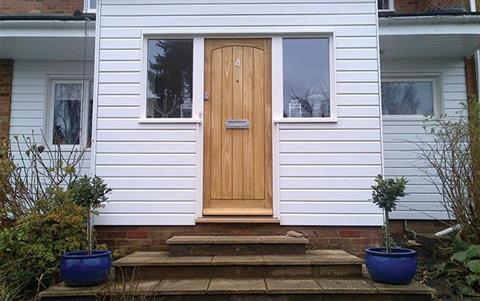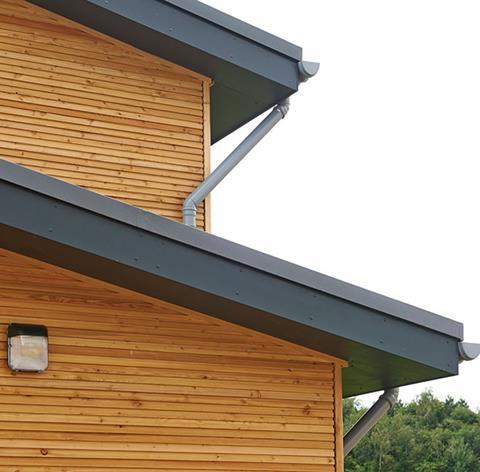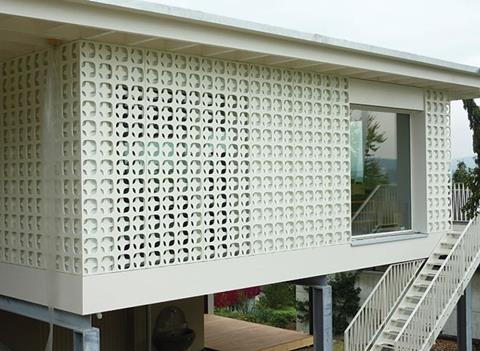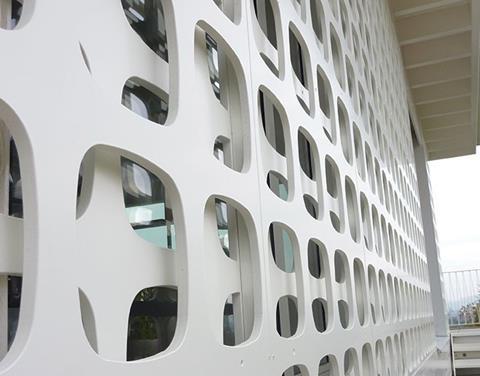Acetylated wood panels can offer improved durability and moisture resistance compared to traditional MDF. This module, sponsored by Medite Tricoya Extreme, outlines their key advantages and uses

How to take this module
UBM’s CPD distance-learning programme is open to anyone seeking to develop their knowledge and skills. Each module also offers members of professional institutions an opportunity to earn between 30 and 90 minutes of credits towards their annual CPD requirement.
This article is accredited by the CPD Certification Service. To earn CPD credits, read the article and then click the link below to complete your details and answer the questions. You will receive your results instantly, and if all the questions are correctly answered, you will be able to download your CPD certificate straight away.
CPD CREDITS: 60 MINUTES
DEADLINE: 24 OCTOBER 2014

INTRODUCTION
Medium-density fibreboard, or MDF, is a versatile wood-based building material made by bonding wood fibres with resin at high pressure and temperature. It is stiff, strong, easily machined and cut, and can be used on a vast range of applications including furniture and interior fittings. However, as with most wood products, it has some disadvantages: dry wood is inclined to swell and shrink in response to changes in moisture in the atmosphere, and on external applications it can be susceptible to degradation due to attack by microorganisms such as fungi.
MDF can be made inherently more stable and durable through a proprietary process known as acetylation, which essentially changes the chemical structure of the wood to make it highly moisture-resistant. Panels made from wood modified by this method can be used in a vast range of high-moisture and weather-exposed applications, including:
- Rainscreen cladding and facades
- Fascia and soffit panels and other secondary exterior applications
- Window and door components, panels and door skins
- Wet interiors, including wall linings in swimming pools, bathrooms, wet rooms and changing room lockers and cubicles
- Garden buildings and landscape products, such as planters and fencing components
- Exterior and speciality furniture
- Signage and shopfronts
This CPD will explain how acetylation works and examine the performance characteristics of acetylated wood panel products, as tested against relevant British and European standards and in comparison to alternative products.

WHAT IS ACETYLATION?
The physical properties of any material are determined by its chemical structure. Softwood, which is more environmentally sustainable than hardwood but less durable, contains an abundance of chemical groups called free hydroxyls. These absorb and release water according to changes in climatic conditions, the main reason why wood swells and shrinks. The digestion of wood by enzymes also starts at the site of free hydroxyls, one of the reasons why wood, and softwood in particular, is prone to decay.
The acetylation process works by introducing acetic anhydride, which comes from acetic acid (or vinegar), to the wood, causing a chemical reaction. This changes the chemical make-up of the wood, replacing the free hydroxyls with groups of more moisture-resistant molecules known as acetyls. The ability of the wood to absorb water is greatly reduced, rendering it more dimensionally stable, durable and less susceptible to decay.
MANUFACTURE OF ACETYLATED MDF
The manufacturing process for acetylated MDF is essentially the same as any MDF product. The wood is acetylated as softwood chips and refined into fibre which is then mixed with high-performance formaldehyde-free resin and other non-toxic additives. The fibres are transferred onto a conveyor belt to be heated and pressed to make a master panel. Once cooled, the master panel is sanded to the target thickness, cut to size, packaged and labelled.
The whole process is continuously monitored using a variety of equipment including photocells, gauge thickness rollers and ultrasonic scanners. Samples are also taken during the process to test thickness swell performance, density, thickness and internal bond strength.

PERFORMANCE BENEFITS OF ACETYLATED WOOD
The greatly enhanced moisture resistance of acetylated wood brings a number of related benefits. These include:
Durability Because the wood is no longer digestible, it is highly resistant to attack from wood-destroying fungi, such as basidiomycetes (brown and white rot), as well as beetles and termites. Tests conducted by Swedish research institute SP Wood Technology using the ENV 807 test method indicate the increased durability gained by acetylation. Mass loss in all of the boards made from unmodified wood material exceeded 30% over the test period, while for acetylated boards it was less than 3%. Tests carried out in Australia over a prolonged period demonstrated the product’s ability to withstand the most veracious termites, with only 0.6% loss in mass. In comparison, sections of western red cedar, which is considered to be relatively resistant to termites, lost in excess of 29% of their mass.
Dimensional stability Due to its inherent moisture resistance, acetylated wood is able to resist shrinking or swelling as humidity levels change. By way of comparison, the Department of the Environment’s Handbook of Softwoods (1977) suggests that the tangential and radial movement of Scots pine at 90% relative humidity is 2.1%. This is a particularly important factor in external joinery. While other preservative treatments for wood, such as oils, ammonia or metal compounds, can improve durability, they have no effect on dimensional stability. As a result of its dimensional stability and durability, acetylated MDF can be used in applications where traditional MDF panels cannot.

Coatability Conventional water-based paint coatings may be used as a finish, and melamine papers, high-pressure laminates and foils can also be adhered to the panels. Substrates that are dimensionally stable in different moisture conditions exert less stress on any applied surface coating - which means the coating’s service life is extended, and the need for maintenance is greatly reduced.
Non-toxicity Because acetyl groups are naturally occurring, the end product does not add toxins to the environment. The British Board of Agrément (BBA) has also concluded that the acetic acid present in acetylated wood (specifically Accsys Technologies’ Accoya product) is not toxic to humans. The European Collaborative Action Report “Indoor Air Quality and Its Impact on Man” gives an air quality guideline for acetic acid of 0.1ppm, for which producer Medite Europe recommends the use of dust extraction with a minimum air velocity of 23-30m/s. During manufacture, this means that normal vacuum extraction for wood dust can be used.
Recyclability As with some other MDF products, acetylated MDF uses pMDI resin as a binder, which does not contain formaldehyde. As well as making exposure to the products safer, this means that they are potentially fully recyclable. Both offcuts produced during product processing and the product at the end of its life can be safely used as biomass to generate energy.

RELEVANT STANDARDS AND TESTING METHODS
There are no standards specifically written to give guidance on or requirements for specification of acetylated MDF. However, organisations such as BRE, SP Wood Technology and wood research institute Fraunhofer WKI have tested products against British and European standards for the use of solid wood and wood-based panels. Relevant standards include the following:
BS EN 350-2:1994 Durability of wood and wood-based products, Natural durability of solid wood
This assesses the natural durability of selected wood species of importance in Europe against wood-destroying fungi, drywood-destroying beetles, termites and wood pests in sea water. It should be used in conjunction with BS EN 335-1: 2013, which assigns use classes to different applications - for example, external cladding is use class 3.
BS EN 350-2 categorises natural durability against wood-destroying fungi in five durability classes, ranging from 1 (highly durable) to 5 (non-durable). For example, when used for external cladding, western red cedar is classed as 2 (durable), while Scots pine is classed as 4 (slightly durable). Exposure tests by the Fraunhofer Institute for Wood Research (Fraunhofer WKI) indicate that acetylated MDF has a natural durability class of 1 - the same as preservative-treated wood and endangered old growth teak, and more durable than oak. This class means that testing resulted in a loss of wood mass of 3% or lower.
BS 8417:2011+A1:2014 Preservation of timber, Code of practice
This sets out a framework for UK specifiers to interpret the European standards and links the natural durability class to a service life. For external joinery, a 15-, 30- or 60-year service life is satisfied by choosing timber of class 4, 3 or 2 respectively.

BS EN 13986:2004 Wood-based panels for use in construction - Characteristics, evaluation of conformity and marking
This summarises the performance requirements for wood-based panels for use in structural and non-structural applications. It covers such characteristics as bending strength, bonding quality, tensile strength, moisture resistance, thermal conductivity, biological durability and release of formaldehyde. BS EN 13986 includes two tables with requirements for general purpose boards for use in humid conditions (type MDF, H) and for load-bearing boards for use in humid conditions (type MDF, HLS). For the purposes of assessing Medite’s Tricoya Extreme acetylated MDF panels for the British Board of Agrément, Fraunhofer WKI used Type MDF, HLS as a point of comparison. BS EN 13986 cross-references the BS EN test methods detailed in the table below.
BS EN 321: 2002 Wood-based panels. Determination of moisture resistance under cyclic test conditions
This contains a method for artificially weathering panels, so that the performance characteristics detailed in BS EN 13986 can be tested after exposure to extreme wet conditions and fluctuating temperatures. It repeats the following wet-dry and freeze-thaw cycles three times:
- The panel is immersed in a fresh water bath (pH 7) for 70 hours at 20˚C
- It is removed from the bath and allowed to drain for a few minutes
- It is placed in a freezer cabinet between -12˚C and -25˚C for 24 hours
- It is removed from the freezer cabinet and immediately placed in a drying cabinet at 70˚C for 70 hours
- It is removed from the drying cabinet and allowed to cool to room temperature (20˚C +/- 5˚C) for four hours.
Fraunhofer WKI’s tests on acetylated MDF for the BBA used an alternative method, as set out in DIN EN 12467, as it was deemed to be more closely representative of panels used in an external application. The sequence is described in the table on the following page.
| Wet-dry | Freeze-thaw |
|---|---|
| Phase 1: Storage in water at 20ºC for 18 hours | Phase 1: Storage in water at 20ºC for three hours |
| Phase 2: Drying at 60ºC and 20% relative humidity for six hours | Phase 2: Freezing at -20ºC for three hours |
These cycles were each repeated 25 times on a 12mm-thick Medite Tricoya Extreme board made using acetylated spruce fibres (MDF A) and a 12mm-thick MDF board made from non-acetylated spruce fibres (MDF D). The results of the subsequent testing to BS EN 13986 requirements are shown in the table below:

How to take this module
UBM’s CPD distance-learning programme is open to anyone seeking to develop their knowledge and skills. Each module also offers members of professional institutions an opportunity to earn between 30 and 90 minutes of credits towards their annual CPD requirement.
This article is accredited by the CPD Certification Service. To earn CPD credits, read the article and then click the link below to complete your details and answer the questions. You will receive your results instantly, and if all the questions are correctly answered, you will be able to download your CPD certificate straight away.
CPD CREDITS: 60 MINUTES
DEADLINE: 24 OCTOBER 2014
Privacy policy
Information you supply to UBM Information Ltd may be used for publication and also to provide you with information about our products or services in the form of direct marketing by email, telephone, fax or post. Information may also be made available to third parties. UBM Information Ltd may send updates about ��ɫ����TV CPD and other relevant UBM products and services. By providing your email address you consent to being contacted by email by UBM Information Ltd or other third parties. If at any time you no longer wish to receive anything from UBM Information Ltd or to have your data made available to third parties, contact the Data Protection Coordinator, UBM Information Ltd, FREEPOST LON 15637, Tonbridge, TN9 1BR, Freephone 0800 279 0357 or email ubmidpa@ubm.com. View our full privacy policy at






















No comments yet